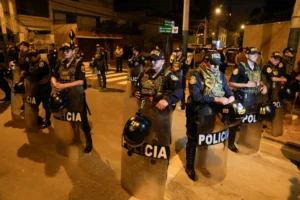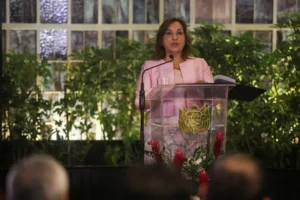Peru’s president Dina Boluarte’s home in Surquillo district of Lima, Peru was raided as a part of a corruption investigation related undisclosed luxury Rolex watches early on Saturday, 30 March, 2024.
The raid was a joint operation conducted by the police and the prosecutor’s office. The investigation initially began after a news outlet La Encerrona highlighted the president’s wearing of highly expensive watches since she took office in December, 2022.
Dozens of armed officers including the police and prosecutors participated in the raid, which involved breaking down the door of Boluarte’s residence using a sledgehammer. This action was authorized by the Supreme Court of Preparatory Investigation, following her failure in providing proofs of purchase for the watches and refusal in letting the authorities into her home.

This event has sparked immense controversy and political turmoil in Peru, with critics accusing the government of authoritarian behavior and calling for transparency and accountability and Boluarte denying any wrongdoing. The developments in this case can have severe implications for Peru’s political landscape.
Context, Details and Reactions
As previously mentioned, the scene unfolded in the Surquillo district of Lima, where officers blocked off the area for the execution of the operation. Even though government agents were present, the President herself was notably absent from her home. The authorities also entered the Government Palace for further investigation.
The presidency has assured the public that the raid took place without incident and with full cooperation from the palace’s personnel. However, criticism from government officials and allies swiftly followed.
The Prime Minister, Gustavo Adrianzen, denounced the raid as disproportionate and unconstitutional. He highlighted that the chaos is serious and “affecting investments and the entire country.”
The president herself addressed the public later on Saturday. She condemned the police raiding her home and the presidential palace, declaring the actions “arbitrary, disproportionate and abusive.” She stated that she started her presidency with clean hands and will retire only in 2026.
What does the Rolex Case involve?
The raid was a part of an anti-corruption investigation over an undeclared Rolex watch collection Dina Boluarte possesses. After reviewing thousands of photographs of the President, La Encerrona had determined that she owned at least 14 luxury watches. Her lawyer, Mateo Castaneda, stated that the police had taken photos of approximately 10 watches but he could not confirm what brands they were.
After La Encerrona’s report, the president was questioned about her watches. She had stated that her being able to afford those watches was a product of hard work she did since she was 18 years old, advising the media not to delve into personal matters.

Boluarte requested to delay her appearance before court by two weeks – a move that was criticized by Attorney General Juan Villena this week. Villena emphasized her obligation to cooperate with the investigation and provide the required proofs. He also stated that the president is obligated to produce her watches and warned against their disposal or destruction. The government comptroller has announced that it will review Boluarte’s asset declarations from the past two years for any irregularities.
Experts have estimated the value of the watches to be approximately $500000. Many people believe she didn’t have the means to buy these watches, considering that she made a salary of about $1000 when she was the head of a government institution and makes about $4300 now.
Dissent rises against the President
Dina Ercilia Boluarte Zegarra has served as the President of Peru since 7 December, 2022. She had previously served as the first vice president and minister at the Ministry of Development and Social Inclusion under President Pedro Castillo and an officer at the National Registry of Identification and Civil Status (RENIEC) from 2007 until 2022.
Her ascent to the presidency took place following the tumultuous events triggered by former President Pedro Castillo’s attempt to dissolve Congress and govern by decree, resulting in his swift removal and subsequent arrest. The aftermath of these events saw widespread unrest, leading to the deaths of at least 49 individuals during protests.

Critics have raised concerns about Boluarte’s administration, alleging a tilt toward authoritarianism. They point to her government’s resistance to calls for early elections and collaboration with Congress on legislation that is perceived as compromising for the independence of Peru’s judicial system.
Boluarte’s public perception has been overwhelmingly negative as evidenced by multiple opinion polls conducted in Peru. According to polls conducted by the Institute of Peruvian Studies (IEP) and other organizations, a significant majority of respondents have consistently expressed disapproval of Boluarte’s leadership. There is widespread dissatisfaction with her presidency and a negative outlook towards her leadership and the performance of the Congress under her. Despite this general disapproval, a small percentage of Peruvian CEOs have expressed approval of Boluarte and supported her remaining in office until 2026.










